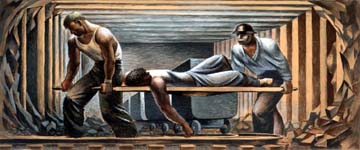

Both of these murals are by the American artist Fletcher Martin. Both were painted as part of the New Deal WPA project that funded writers and painters and other artists for commissions made by the federal government. Fletcher painted these two murals for the new United States Post Office in Kellogg, Idaho. They differ greatly from one another.
The top mural is set in the present (c.a. 1939). In portrays two muscular and determined miners rescuing a fellow miner after an accident. To me, it portrays two realities of work underground. The first is obvious: mining is dangerous. This mural accents the danger of mining in its claustrophobic framing of the miners. The ceiling is low and the tunnel, while rounded in the foreground, is more vertical and horizontal in the mine itself, as if these workers are imprisoned in their work.
The second reality has to do with the miners' brotherhood, their reliance on one another. In this regard, the mural is heroic. The miners look like soldiers carrying a stretchered and battle-wounded fellow soldier off the battlefield. The scene of rescue evokes fear and admiration. It underscores how much miners depend on one another for their safety and for aid in time of crisis.
The bottom mural is a more nostalgic one. It celebrates the moment a mine is discovered. It alludes to the iconic jackass of Noah Kellogg. Legend has it that the jackass of Noah Kellogg wandered off and when Kellogg went to find the animal, he discovered an outcropping of precious metal ore and the rich Bunker Hill and Sullivan mine was discovered.
The two men in this picture do not evoke our empathy. They almost seem outside of history. It is almost a pastoral scene. The jackass is content. The prospectors are enthusiastic about their discovery. The mural barely touches upon the reality of labor, let alone the danger.
When Fletcher Martin originally won the competition to paint the Kellogg mural, he painted the top picture. The Mine Workers and Smelt Workers of Local 18, members of the union, praised the mural and supported Martin's work. Not so the Kellogg industrialists. They argued that the mural would pain those who had lost loved ones in the mines.
At first, the government defended Martin's first mural, but eventually gave in. Martin painted the second mural, which I believe can still be seen in the Kellogg Post Office, a much less controversial piece. Rather than approve a mural that brought to life the present and lasting danger of the mining as well as the service of miners to one another, the company prevailed in having Martin paint a romanticized sort of nativity scene of the birth of mining in Kellogg.
I favor the social realism of the top mural. That mural vivifies the constant struggle against danger and mortality workers face in their labor. Honoring men working and simultaneously having one another's backs in such working conditions would have been a way to acknowledge the risks miners took to earn their wages and to produce the ore that made the mining company prosperous. This mural also humanizes their work. They cannot be regarded as mere cogs in a mining machine.
But, the industrialists wanted a mural that looked backward, that portrayed the miraculous moment when the mine was discovered, as if it were a picture in an illustrated Bible. It makes sense. It creates a more upbeat story. It allows postal customers to escape the realities of the world of labor around them rather than face mining's demands straight on and feel pride for miners and their courage.
No comments:
Post a Comment